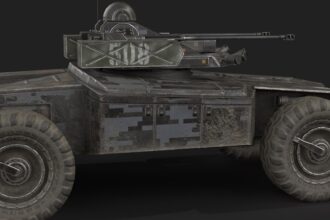Throughout history, the evolution of warfare has often been marked by the introduction of innovative and cost-effective weaponry. Cheap weapons have played a pivotal role in shaping battles and altering the course of history. These weapons, often accessible to the masses, have empowered smaller or less affluent forces to challenge more powerful adversaries.
From rudimentary tools crafted from available materials to more sophisticated designs that require minimal resources, cheap weapons have demonstrated their effectiveness time and again. Their significance lies not only in their affordability but also in their ability to level the playing field, allowing the underdog to stand against seemingly insurmountable odds. The concept of cheap weapons extends beyond mere financial considerations; it encompasses the ingenuity and resourcefulness of those who wield them.
In many instances, these weapons have been born out of necessity, reflecting the creativity of individuals and groups who sought to defend their homes or assert their rights. As history unfolds, the impact of these inexpensive armaments becomes evident, revealing a narrative of resilience and strategic innovation. The following sections will explore various historical battles and conflicts where cheap weapons played a crucial role, illustrating their enduring legacy in the annals of warfare.
Key Takeaways
- Cheap weapons have played a significant role in shaping the outcomes of historical battles and wars.
- The phalanx formation was a powerful and effective tactic used in the Battle of Thermopylae.
- Guerrilla warfare was instrumental in the success of the American Revolution against the British.
- The longbow had a profound impact on the Battle of Agincourt, demonstrating the effectiveness of ranged weapons.
- Improvised explosive devices proved to be highly effective in the Vietnam War, showcasing the power of cheap and easily accessible weapons.
The Battle of Thermopylae: The Power of the Phalanx
The Battle of Thermopylae in 480 BCE stands as a testament to the effectiveness of the Greek phalanx formation, a military tactic that relied on inexpensive yet formidable weaponry. The Greeks, primarily composed of Spartan warriors, utilized long spears and shields to create a wall of defense against the invading Persian army. This formation allowed them to maximize their strength while minimizing their vulnerability, demonstrating how a well-coordinated group armed with simple weapons could hold off a vastly larger force.
The phalanx was not only a display of military might but also a reflection of the social structure within Greek city-states. The soldiers, known as hoplites, were typically citizens who could afford their own armor and weapons, yet the simplicity of the phalanx allowed even those with limited resources to contribute effectively to their defense. The unity and discipline required for this formation transformed ordinary citizens into formidable warriors, showcasing how cheap weapons could be wielded with devastating effect when combined with strategic planning and collective effort.
The American Revolution: The Role of Guerrilla Warfare

During the American Revolution, the colonists faced a well-trained British army equipped with advanced weaponry.
The use of rifles, which were cheaper and more accessible than muskets, allowed American forces to engage in hit-and-run tactics that disrupted British supply lines and communication.
This unconventional approach not only leveled the playing field but also instilled a sense of confidence among the colonists. The effectiveness of guerrilla warfare during this period highlighted the importance of adaptability in combat. American forces often employed ambushes and surprise attacks, utilizing their intimate understanding of the landscape to outmaneuver their opponents.
The reliance on cheap weapons and unconventional tactics proved instrumental in undermining British authority and ultimately securing independence for the colonies. This conflict underscored how resourcefulness and strategic innovation could triumph over superior firepower.
The Battle of Agincourt: The Longbow’s Impact on History
| Aspect | Impact |
|---|---|
| Battle Outcome | English victory over the French |
| Longbow Usage | Longbows played a crucial role in the English victory |
| Casualties | English suffered minimal casualties compared to the French |
| Tactical Advantage | Longbows provided the English with a significant tactical advantage |
| Historical Significance | The battle demonstrated the effectiveness of longbows in medieval warfare |
The Battle of Agincourt in 1415 marked a significant turning point in medieval warfare, largely due to the introduction of the English longbow. This weapon, relatively inexpensive to produce and easy to master with practice, allowed English archers to unleash devastating volleys against French knights who were heavily armored and costly to equip. The longbow’s range and power rendered traditional cavalry charges ineffective, showcasing how a cheap weapon could alter the dynamics of battle.
The success of the longbow at Agincourt not only demonstrated its tactical advantages but also signaled a shift in military strategy during the Hundred Years’ War. The English army’s ability to inflict heavy casualties on their opponents without engaging in close combat highlighted the importance of ranged weaponry in warfare. This battle exemplified how affordable armaments could empower smaller forces to achieve remarkable victories against larger, more heavily armed adversaries.
The Vietnam War: The Effectiveness of Improvised Explosive Devices
In the Vietnam War, improvised explosive devices (IEDs) emerged as a powerful tool for the Viet Cong and North Vietnamese forces. These devices were often constructed from readily available materials, making them both cost-effective and highly effective against technologically superior American forces. The use of IEDs allowed guerrilla fighters to disrupt supply lines and inflict casualties without engaging in direct confrontation, showcasing how cheap weapons could be employed strategically in asymmetric warfare.
The psychological impact of IEDs cannot be overstated; they instilled fear among American troops who faced an invisible enemy capable of striking at any moment. This tactic forced U.S. forces to adapt their strategies and invest heavily in countermeasures, illustrating how inexpensive weaponry could shift the balance of power in a conflict.
The Vietnam War serves as a stark reminder that resourcefulness and innovation can often outmatch advanced technology when it comes to warfare.
The Battle of Stalingrad: The Use of Molotov Cocktails

The Battle of Stalingrad during World War II showcased the effectiveness of simple yet deadly weapons like Molotov cocktails. As Soviet forces faced a relentless German assault, they resorted to using these improvised incendiary devices to combat enemy tanks and infantry. Constructed from readily available materials such as glass bottles filled with flammable liquid, Molotov cocktails became symbols of resistance against overwhelming odds.
The use of Molotov cocktails not only demonstrated the resourcefulness of Soviet defenders but also highlighted the desperation that characterized urban warfare during this period. As traditional military strategies faltered in the face of urban combat’s complexities, these cheap weapons provided an effective means for defenders to level the playing field against a technologically advanced enemy. The Battle of Stalingrad ultimately became a turning point in World War II, illustrating how even the simplest weapons could have profound implications on the course of history.
The Boer War: The Significance of the Maxim Gun
The Boer War (1899-1902) marked a significant moment in military history with the introduction of the Maxim gun, one of the first machine guns ever used in combat. Although not particularly cheap by modern standards, its ability to deliver sustained fire made it a game-changer on the battlefield. The Boers, utilizing this weapon effectively against British forces, demonstrated how even relatively affordable technology could dramatically alter traditional warfare dynamics.
The Maxim gun’s impact was felt throughout the conflict as it allowed Boer fighters to defend their positions against larger British forces with relative ease. Its effectiveness highlighted a shift towards mechanized warfare that would define future conflicts. While not as inexpensive as other weapons discussed, its relatively low cost compared to traditional artillery made it accessible for smaller forces seeking an edge against more powerful adversaries.
The Battle of Marathon: The Importance of the Greek Phalanx
The Battle of Marathon in 490 BCE is another pivotal moment that underscores the significance of cheap weaponry in warfare.
Armed primarily with spears and shields that were relatively inexpensive to produce, Athenian soldiers demonstrated how disciplined formations could overcome numerical disadvantages.
The victory at Marathon not only showcased the effectiveness of cheap weapons but also solidified Athenian democracy’s role in shaping Western civilization. The ability of ordinary citizens to take up arms and defend their city-state against a formidable foe became a defining moment in Greek history. This battle exemplified how collective action and strategic use of affordable weaponry could lead to monumental victories that resonate through time.
The Siege of Tyre: The Use of Siege Towers and Battering Rams
The Siege of Tyre in 332 BCE illustrated how ancient armies employed relatively simple yet effective siege technologies like towers and battering rams to breach fortified cities. While these siege engines required some investment in materials and labor, they were far less costly than full-scale military campaigns involving extensive resources. Alexander the Great’s successful siege relied on these innovations to overcome Tyre’s formidable defenses.
The use of siege towers allowed attackers to gain height advantage over city walls while battering rams provided a means to break through gates or walls with relative efficiency. This combination showcased how ingenuity in engineering could turn simple concepts into powerful tools for conquest. The Siege of Tyre serves as an example of how affordable technology can play a crucial role in determining the outcome of military engagements throughout history.
The Battle of Hastings: The Impact of the English Longbow
The Battle of Hastings in 1066 marked another significant moment where cheap weaponry played a crucial role in shaping history. The English longbowmen proved instrumental in defeating William the Conqueror’s Norman forces. Armed with longbows that were relatively inexpensive compared to heavy armor or cavalry charges, English archers unleashed devastating volleys that decimated enemy ranks before they could engage in close combat.
This battle highlighted not only the tactical advantages offered by ranged weaponry but also signaled a shift away from traditional knightly warfare dominated by heavily armored cavalry. The success at Hastings underscored how affordable armaments could empower common soldiers and reshape societal structures within medieval Europe. It became clear that even simple weapons could have far-reaching implications for political power dynamics.
The Enduring Legacy of Cheap Weapons in History
The exploration of various historical battles reveals an enduring truth: cheap weapons have consistently played a transformative role in warfare throughout history. From ancient phalanxes to modern improvised explosive devices, these armaments have empowered individuals and groups facing overwhelming odds. Their significance lies not only in their affordability but also in their ability to inspire innovation and strategic thinking among those who wield them.
As societies continue to evolve, so too does the nature of conflict and warfare. However, the lessons learned from past encounters remind us that resourcefulness often triumphs over sheer might. Cheap weapons will likely remain integral components of military strategy for generations to come, serving as reminders that ingenuity can shape history just as profoundly as advanced technology ever could.
In the annals of military history, there are numerous instances where inexpensive weapons have played pivotal roles in determining the outcomes of conflicts. A related article that delves into this topic can be found on the website “In The War Room.” This article explores various historical examples where cost-effective weaponry provided strategic advantages, often turning the tide in favor of those who wielded them. For a deeper understanding of how these economical tools of war have shaped battles throughout history, you can read more by visiting this article.
FAQs
What are some historical examples of cheap weapons winning?
Some historical examples of cheap weapons winning include the use of longbows by the English at the Battle of Agincourt, the use of guerrilla tactics and simple weapons by the Viet Cong during the Vietnam War, and the use of improvised explosive devices (IEDs) by insurgents in modern conflicts.
How did the longbow contribute to the English victory at the Battle of Agincourt?
The longbow was a relatively cheap and simple weapon, but it played a crucial role in the English victory at the Battle of Agincourt in 1415. The English longbowmen were able to rain down a devastating hail of arrows on the French forces, causing significant casualties and contributing to the English triumph.
What role did guerrilla tactics and simple weapons play in the success of the Viet Cong during the Vietnam War?
The Viet Cong, a communist guerrilla force in Vietnam, utilized guerrilla tactics and simple weapons such as booby traps, mines, and small arms to great effect during the Vietnam War. Their ability to blend in with the local population and launch surprise attacks on American and South Vietnamese forces contributed to their success in the conflict.
How have insurgents used improvised explosive devices (IEDs) in modern conflicts?
Insurgents in modern conflicts have used improvised explosive devices (IEDs) as cheap and effective weapons to target military forces and civilians. These homemade bombs have been responsible for a significant number of casualties and have posed a major challenge for conventional military forces.




